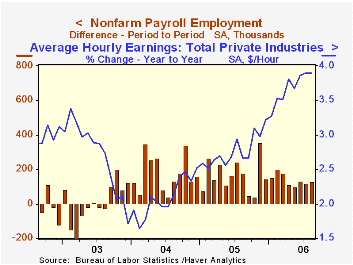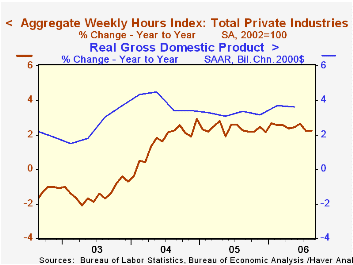 Global| Sep 01 2006
Global| Sep 01 2006U.S. Payrolls On Target
by:Tom Moeller
|in:Economy in Brief
Summary
In August, nonfarm payrolls rose 128,000 and about matched Consensus expectations for a 125,000 gain. For the prior month, the increase was upwardly revised up slightly to 121,000. Year to date payrolls have risen an average 141,000 [...]

In August, nonfarm payrolls rose 128,000 and about matched Consensus expectations for a 125,000 gain. For the prior month, the increase was upwardly revised up slightly to 121,000.
Year to date payrolls have risen an average 141,000 per month versus an average gain of 165,000 last year and an average 175,000 during 2004.
From the household survey the unemployment rate fell back to 4.7%, as expected, from 4.8%. Employment grew 250,000 (1.5% y/y) after the prior month's 34,000 worker decline. The labor force rose 164,000 (1.3% y/y) and the labor force participation rate remained up at 66.2% for the third straight month.
The breadth of one month gain in private payrolls rose slightly to 55.9% in August, though that remained below the April high of 64.4%. In the factory sector the one month breadth of gain fell to a less-than break even 44.6%.
Factory sector payrolls fell 11,000 for fifth the m/m decline this year. Jobs in the motor vehicle & parts industries fell 6,900 (-2.3% y/y) while furniture & related industry jobs also fell by 4,200 (-2.8% y/y). A 3,000 (-0.9% y/y) worker decline in nondurable goods payrolls was broad based but led by a 2,100 (-3.9% y/y) drop in apparel employment and a 3,000 worker (-1.4% y/y) drop in plastics.
Private service-producing jobs rose 101,000 (1.4% y/y) though retail trade sector jobs continued weak fell another 13,500 (-0.7% y/y). Financial sector jobs offset some of that decline with a 10,000 (2.2% y/y) gain and professional & business services employment rose 26,000 (2.7% y/y). Temporary help services jobs rose 3,400 (2.8% y/y) while jobs in education & health services grew 60,000 (2.2% y/y).Government sector jobs grew 17,000 (0.6% y/y).
Construction employment rose 17,000 (2.9% y/y) though the number of jobs in nonresidential construction slipped 1,600 (4.1% y/y).
Average hourly earnings rose just 0.1% after two months of 0.4% & 0.5% increase, and fell short of expectations for a 0.3% rise. The increase in factory sector earnings also rose just 0.1% (1.0% y/y).
The workweek slipped and lowered the index of aggregate weekly hours worked in private industries by 0.2% after a modest 0.1% July gain. During 3Q the average level of the index is up 0.8% (AR) after a 2.6% gain during 2Q. During the last ten years there has been an 81% correlation between the y/y change in aggregate hours worked and real GDP growth.
| Employment | August | July | Y/Y | 2005 | 2004 | 2003 |
|---|---|---|---|---|---|---|
| Payroll Employment | 128,000 | 121,000 | 1.3% | 1.5% | 1.1% | -0.3% |
| Manufacturing | -11,000 | -23,000 | 0.1% | -0.6% | -1.3% | -4.9% |
| Average Weekly Hours | 33.8 | 33.9 | 33.7 (August '05) | 33.8 | 33.7 | 33.7 |
| Average Hourly Earnings | 0.1% | 0.5% | 3.9% | 2.8% | 2.1% | 2.7% |
| Unemployment Rate | 4.7% | 4.8% | 4.9% (August '05) | 5.1% | 5.5% | 6.0% |
Tom Moeller
AuthorMore in Author Profile »Prior to joining Haver Analytics in 2000, Mr. Moeller worked as the Economist at Chancellor Capital Management from 1985 to 1999. There, he developed comprehensive economic forecasts and interpreted economic data for equity and fixed income portfolio managers. Also at Chancellor, Mr. Moeller worked as an equity analyst and was responsible for researching and rating companies in the economically sensitive automobile and housing industries for investment in Chancellor’s equity portfolio. Prior to joining Chancellor, Mr. Moeller was an Economist at Citibank from 1979 to 1984. He also analyzed pricing behavior in the metals industry for the Council on Wage and Price Stability in Washington, D.C. In 1999, Mr. Moeller received the award for most accurate forecast from the Forecasters' Club of New York. From 1990 to 1992 he was President of the New York Association for Business Economists. Mr. Moeller earned an M.B.A. in Finance from Fordham University, where he graduated in 1987. He holds a Bachelor of Arts in Economics from George Washington University.






